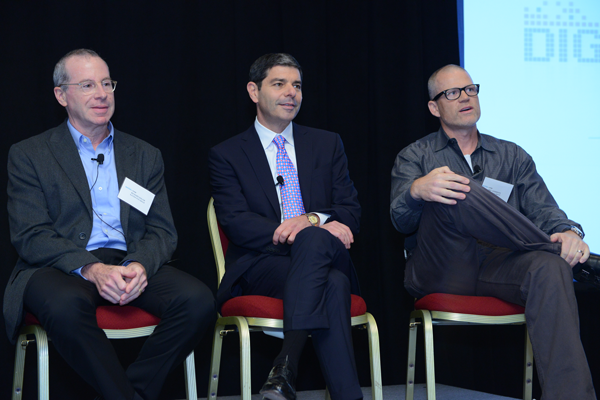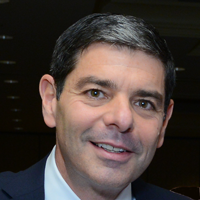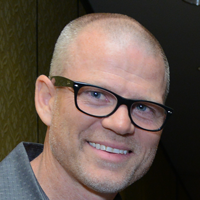
VM LIVE’s ‘Digitizing the Store’ was presented by (l-r) Richard Edlow, OD; Jonathan Rosin, MD; and Eric Anderson.
LAS VEGAS— A group of leading eyecare professionals presented a variety of techniques for “Digitizing the Store” at the latest VM LIVE event where they shared the following technologies that have been successfully implemented into their practices. Like these multiple-location regional and national eyecare and eyewear providers, you too can improve patient care while boosting your bottom line using the following electronic systems to automate many of your routine processes and day-to-day functions.
Innovative Technologies that Save Dollars

Richard Edlow, OD,
president, Katzen Eye Group
With six locations in Maryland,
Katzen Eye Group’s multidisciplinary practice uses a variety of technologies to provide better patient care and lower transaction costs. During the VM LIVE event on “Digitizing the Store,” president Richard Edlow, OD, discussed how this vertically integrated “three Os” practice employs specific technologies to save money with each of many practice/patient interactions.
Some specific technologies that Katzen Eye Group has implemented to save money or generate revenue every time certain interactions take place between patients and the practice include customer relation management software, patient reactivation software, a program to fill appointments left empty by last-minute cancellations, electronic portals, and registration kiosks.
For example, the practice saves nearly a dollar every time it texts or emails appointment confirmations to patients. Electronic reminders cost Katzen only nine cents when compared with $1.04 per telephone call.
“The best thing, and worst thing, about our practice is that we see 600 patients a day,” Edlow said to indicate how the size and volume of his multiple-location practice can result in significant cost savings with just one dollar savings per patient. “We have over 32,000 email addresses and 114,900 cellphone numbers to email or text to let people know that their glasses are ready,” added Edlow, indicating the efficiency with which his practice’s customer relations management software communicates with his patients.
Using
Brevium patient reactivation software, which calls patients who have not been in recently for an appointment, has generated millions of dollars in revenue for Katzen Eye Group. By mining data from practice management software regarding a patient’s condition at their last appointment, the Brevium patient reactivation software has helped generate $2.6 million for the practice over the last four years, according to Edlow.
In addition,
Everseat software enables the practice to fill schedules left empty by last-minute cancellations at a cost of only $3.28 per filled appointment. Fulfilling contact lens orders via
MyEyeStore online costs only 40 cents per order rather than the $5.20 is costs when those orders are fulfilled in-office. Electronic portals allow patients to request appointments, pay bills, and get receipts, among other functions. Edlow said that bills paid online cost just a penny compared with bills paid by mail, which cost 72 cents.
Katzen Eye Group even offers patients the opportunity to register at a kiosk in the waiting room, rather than at the receptionist’s desk, and verify their insurance at the same time. Edlow shared with the audience the savings that result. “Registering manually by staff costs $9.43 and registering electronically by staff costs $7.93, but registering by kiosk costs only $4.72,” he said, “and they can pay at the kiosk too.”
“Eyecare’s changing,” concluded Edlow, “and technology is making it better.”
Staff Training Benefits the Patient Experience

Jonathan Rosin, MD,
co-owner, Rosin Eyecare
Rosin Eyecare serves “Millennials to Boomers” through a 19-location regional chain in Chicago. The next speaker at the VM LIVE “Digitizing the Store” event, Jonathan Rosin, MD, co-owner of Rosin Eyecare, referred to this similarly multidisciplinary practice as O-cubed.
One of the strategies this company employs to compete among the “nationals, regionals, and independents” practicing in Chicago is to embrace its own training by bringing it in-house. The company “digitized” its training by creating a web-based program consisting of 38 chapters, each of which takes about a half hour to review online. Opticians are required to complete a pre-test, go through every chapter, and then take a post-test.
After “creating product experts,” as Rosin refers to those who have completed the program, a number of benefits have emerged. “Patient satisfaction is way up, there’s been an increase in upsell and a significant decrease in remakes,” he said.
Rosin also described how his multiple-location practice is “digitizing” its marketing as well. The company instituted the use of customer relationship management software that opens various channels to both create personalized messages for patients as well as provide them with a platform to voice their opinions to the practice. With this, Rosin can “anticipate the needs and desires of patients,” he said, adding, “We lost about $100,000 in payroll but gained more connection to our patients.”
Among the recommendations Rosin made to the audience at the conclusion of his presentation was to “invest in technology that enhances the patient experience because that is what it’s all about.”
Addressing Omnichannel Expectations

Eric Anderson, president and
general manager, LensCrafters
Representing
LensCrafters, Eric Anderson presented an overview of how the nation’s largest optical retailer is creating a more personalized customer experience, both online and in its stores. He drew a line between “digital natives”—Millennials who have grown up with digital technology—and older consumers like himself whom he called “digital immigrants.”
He described how LensCrafters is meeting consumer expectations by delivering what he called ‘”eye love.” The retailer uses an omnichannel marketing approach that involves “a seamless customer interaction, online to in-store,” he said.
LensCrafters’ customer engagement often begins when customers create an account on LensCrafters.com. “Fifty percent of customers visit the site before visiting a LensCrafters store, and 25 percent of those customers book their exams online,” according to Anderson. He added that 25 percent of the stores have full digital pre-text, “so a rich dialogue can occur with the patient.”
Inside the store, LensCrafters employs a mix of technologies, including tablets that are used by all LensCrafters associates, customer relationship management software, and the AccuExam and AccuFit devices for testing patients’ vision and fitting their eyewear.
Anderson noted that LensCrafters’ website is designed to drive customers to its stores, and is not used for online purchases. He emphasized that, “If we go into that space [online retailing], we need to create the same amazing experience as in our stores.”
Offering advice to the retailers in the audience, Anderson cited what he called “the three truths of digital.”
“Digital is only the enabler,” he said. He added that retailers need to “maintain flexibility in technology choices” and “invest in change management” because “adoption takes time.”
Ending on an upbeat note, Anderson concluded, “This is the best time in history to serve customers and patients.”